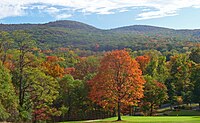
Photo from wikipedia
Unveiling past tipping points is a prerequisite for a better understanding of how individual species and entire ecosystems will respond to future climate change. Such knowledge is key for the… Click to show full abstract
Unveiling past tipping points is a prerequisite for a better understanding of how individual species and entire ecosystems will respond to future climate change. Such knowledge is key for the implementation of biodiversity conservation. We identify the relationships between peatland vegetation and hydrological conditions over the past 2000 years using plant macrofossils, testate amoebae-based quantitative hydrological reconstructions and Sphagnum-moss functional traits from seven Polish peatland records. Using threshold indicator taxa analysis, we discovered that plant community composition strongly converged at a water level of ca 11.7 cm, indicating a community-level tipping point. We identified 45 plant taxa that showed either an increase or a decrease in their relative abundance between 8 and 17 cm of water-level depth. Our analysis of Sphagnum community traits further showed that Sphagnum functional diversity was remarkably stable over time despite Sphagnum species sensitivity to hydrological conditions. Our results suggest that past hydrological shifts did not influence major functions of the Sphagnum community, such as photosynthetic capacity, growth and productivity, owing to species replacement with a similar functional space. Although further studies including trait plasticity will be required, our findings suggest that the capacity of the Sphagnum community to gain carbon remained stable despite hydrological changes.
Journal Title: Biology Letters
Year Published: 2019
Link to full text (if available)
Share on Social Media: Sign Up to like & get
recommendations!